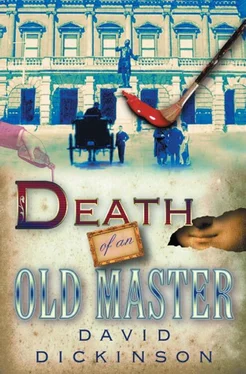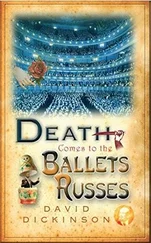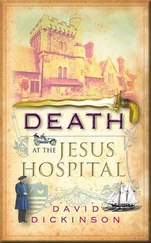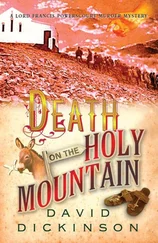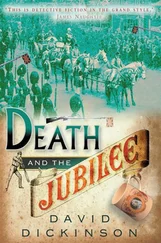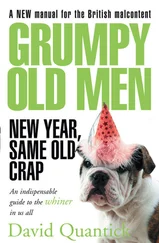David Dickinson - Death of an Old Master
Здесь есть возможность читать онлайн «David Dickinson - Death of an Old Master» весь текст электронной книги совершенно бесплатно (целиком полную версию без сокращений). В некоторых случаях можно слушать аудио, скачать через торрент в формате fb2 и присутствует краткое содержание. Жанр: Исторический детектив, на английском языке. Описание произведения, (предисловие) а так же отзывы посетителей доступны на портале библиотеки ЛибКат.
- Название:Death of an Old Master
- Автор:
- Жанр:
- Год:неизвестен
- ISBN:нет данных
- Рейтинг книги:4 / 5. Голосов: 1
-
Избранное:Добавить в избранное
- Отзывы:
-
Ваша оценка:
- 80
- 1
- 2
- 3
- 4
- 5
Death of an Old Master: краткое содержание, описание и аннотация
Предлагаем к чтению аннотацию, описание, краткое содержание или предисловие (зависит от того, что написал сам автор книги «Death of an Old Master»). Если вы не нашли необходимую информацию о книге — напишите в комментариях, мы постараемся отыскать её.
Death of an Old Master — читать онлайн бесплатно полную книгу (весь текст) целиком
Ниже представлен текст книги, разбитый по страницам. Система сохранения места последней прочитанной страницы, позволяет с удобством читать онлайн бесплатно книгу «Death of an Old Master», без необходимости каждый раз заново искать на чём Вы остановились. Поставьте закладку, и сможете в любой момент перейти на страницу, на которой закончили чтение.
Интервал:
Закладка:
Johnny Fitzgerald helped himself to another bottle of claret from the sideboard. ‘I’m not convinced by that theory, Francis,’ he said, wrestling with the corkscrew. ‘Let’s try another one to do with the art world,’ he went on with a smile as the cork popped out of the bottle. ‘Let’s just think about that exhibition he was writing about. Suppose you were in charge of that. Suppose you hoped to sell lots and lots of lovely Venetian paintings. You hear on the grapevine that somebody is going to denounce most of them as fakes or forgeries. You are going to lose a great deal of money. Twenty Titians, was it, or something like that, they thought they had? Now down to three? Seventeen Titians would have made you pots of money. Now it’s all gone. So they trot round to Brompton Square with a piece of picture cord, ideal for garrotting, and wring Montague’s neck. And, for good measure, they destroy the article and get rid of the compromising books.’
‘That’s not bad, Johnny, not bad at all,’ said Powerscourt. Fitzgerald happily refilled his glass. ‘But there’s one more possibility we shouldn’t discount,’ Powerscourt went on. ‘The only problem is that it has to do with Montague’s will, and we don’t know what that contains. But it could work something like this. Let’s think about Christopher Montague. He has bought his villa near Florence. He has part of one fortune still intact and stands to make many more by attributing works of art for a fee. But somebody couldn’t wait for that to happen. Maybe the somebody was deep in debt and needed money in a hurry. The somebody was going to inherit all he had, including the Italian property. Christopher Montague’s heir was also his murderer.’
‘Have you two quite finished?’ said Lady Lucy. ‘I think all of your theories are perfectly plausible and I am more confused than I was when we started.’
‘I’m sure we could produce some more potential murderers, Lady Lucy,’ said Johnny Fitzgerald cheerfully. ‘Maybe four’s quite enough for now.’
Powerscourt had wandered over to the chessboard. He lifted the Moghul King from its position in the back row and placed it carefully in the centre of the board.
‘Christopher Montague was going to be a King,’ he said sadly, ‘in his own world.’ Powerscourt looked carefully at the chessboard. ‘Maybe his Italian villa was actually a castle. The bishops of the Church would have come to him to know about the authenticity of the pictures on their walls. The art dealers and the art experts would have been the knights, darting in unexpected directions around the black and white squares of his life. Maybe Rosalind Buckley was the Queen. The serried ranks of pawns are the books and the articles Christopher Montague had yet to write.’ Powerscourt picked up a knight and fingered it delicately.
‘For God’s sake,’ he was almost whispering, his mind far away.
‘. . . let us sit upon the ground
And tell sad stories of the death of kings:
How some have been deposed, some slain in war,
Some haunted by the ghosts they have deposed,
Some poisoned by their wives, some sleeping killed . . .’
Powerscourt picked up the King again and returned it gently to the back row.
‘All murdered.’
William Alaric Piper stared in amazement at the front of Truscott Park, home of the Hammond-Burkes. There were builders everywhere, repairing windows, men on the roof taking out the broken tiles, gardeners beginning the long task of restoring the grounds.
‘It does your heart good to see it,’ he said cheerfully to his companion. ‘The healing benison of the Old Masters comes to Warwickshire in the heart of the English Midlands!’
‘It does indeed,’ said Roderick Johnston, senior curator of Renaissance paintings in the National Gallery. Privately Johnston thought with even greater gratitude of the benison of his percentage in the final sale of Raphael’s Holy Family , purchased from Truscott Park for the princely sum of forty-five thousand pounds and sold on for a prince’s ransom, eighty-five thousand pounds, to Mr William P. McCracken, American railroad tycoon and senior elder of the Third Presbyterian Church at Lincoln Street, Concord, Massachusetts. Twelve and a half per cent of eighty-five thousand – he had made the calculation at least a hundred times – was ten thousand, six hundred and twenty-five. Pounds. Roderick Johnston could buy a new house. He could buy a place in the sun large enough to hide from the nagging of his wife.
‘Come,’ said Piper, alighting from the carriage, ‘we must find our host.’ Johnston struggled towards the house with a number of heavy bags, including a number of long metal tubes.
James Hammond-Burke too seemed to have been touched by the benison of the Old Masters. He greeted them warmly in his hall. He smiled. He offered them tea in the morning room, their conversation broken occasionally by the shouts of the builders.
‘Mr Hammond-Burke, good morning to you,’ said William Alaric Piper, in fulsome mood. ‘Allow me to introduce Mr Roderick Johnston, the art expert of whom we spoke earlier. Mr Hammond-Burke. Mr Johnston.’
Piper beamed happily round the room in proprietorial mood. ‘Work has already commenced, I see,’ he said. ‘How proud I am to think that the beautiful Raphael has enabled you, Mr Hammond-Burke, to beautify your own surroundings in this way.’
James Hammond-Burke might have been feeling more cheerful. But he was as keen on money as before. ‘You said that Mr Johnston was going to make a proper inventory of the pictures here,’ he said. ‘What do you think the chances are of finding some more Old Masters?’
Piper looked serious. ‘The quest for beauty is admirable indeed,’ he said, ‘but it will not be rushed.’ Don’t let them raise their hopes too high before we start, he said to himself. ‘Mr Johnston will look at the pictures on display. Then he will search the rest of the house to see if there may be some hidden away in the servants’ bedrooms or piled up at the back of an attic. Then Mr Johnston will work on his inventory. It may not be completed for some time. I see you have already looked out some of the papers and other documents relating to the purchase of the works.’
Piper jumped slightly as a loud crash from outside echoed round the room. It sounded as though an entire section of bricks from the roof had all come down at once. The dust was rising half-way up the windows.
‘My goodness me,’ he said, ‘the price of restoration may be temporary inconvenience, but it will pass. Is everything clear, Mr Hammond-Burke? My carriage is waiting and I propose to leave you in the tender care of Mr Johnston here. You could not be in better hands!’
As his carriage rolled through the countryside back to the railway station, Piper thought again of the asterisk system developed by his partner Edmund de Courcy These told the initiated how severe were the financial problems of the owners of the paintings. One asterisk meant major trouble, might be persuaded to sell. Two asterisks meant technically insolvent, desperate to raise money. And three asterisks meant that financial Armageddon was imminent and might only be averted by the judicious sale of some of the family heirlooms. The fourth asterisk meant a house where rather newer Old Masters could be planted to provide a history and a provenance that would convince unwary buyers. Creating a legend for the painting was how Piper put it to himself. For concealed in Johnston’s luggage was a remarkable Gainsborough, and an eighteenth-century frame, broken down into sections. Johnston was to leave the Gainsborough in an attic for a few days while he worked on the main body of the pictures on the walls of the house. Then it would be discovered. Johnston also had in his possession a couple of documents written on eighteenth-century paper with eighteenth-century ink. These concerned the commission and receipt of a full-length portrait of Mr and Mrs Burke of Truscott Park, Warwickshire, and their two children. The correspondence came from Bath. The signature at the bottom of the documents was of one Thomas Gainsborough, painter and Royal Academician.
Читать дальшеИнтервал:
Закладка:
Похожие книги на «Death of an Old Master»
Представляем Вашему вниманию похожие книги на «Death of an Old Master» списком для выбора. Мы отобрали схожую по названию и смыслу литературу в надежде предоставить читателям больше вариантов отыскать новые, интересные, ещё непрочитанные произведения.
Обсуждение, отзывы о книге «Death of an Old Master» и просто собственные мнения читателей. Оставьте ваши комментарии, напишите, что Вы думаете о произведении, его смысле или главных героях. Укажите что конкретно понравилось, а что нет, и почему Вы так считаете.
